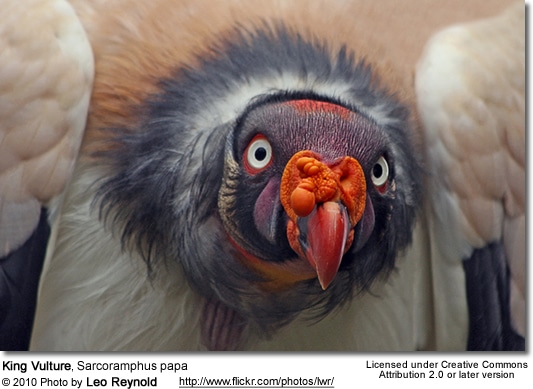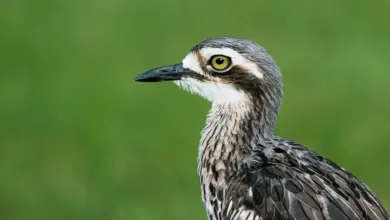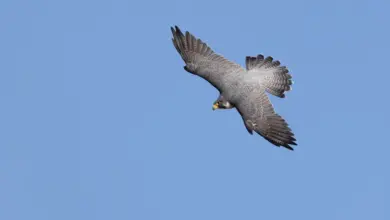Cathartidae: New World Vultures
The New World vultures family Cathartidae contains seven species found in warm and temperate areas of the Americas. It includes five vultures and two condors. Except for Cathartes, all genera are monotypic (genuera consisting of only one species).
The five species of vulture are:
- Turkey Vulture Cathartes aura
- Greater Yellow-headed Vulture Cathartes melambrotus
- Lesser Yellow-headed Vulture Cathartes burrovianus
- King Vulture Sarcorhamphus papa
- American Black Vulture Coragyps atratus

The Condors are
- California Condor Gymnogyps californianus
- Andean Condor Vultur gryphus

Description
These birds are generally large, ranging in length from the Lesser Yellow-headed Vulture at 56–61 centimeters (22–24 in) up to the California and Andean Condors, both of which can reach 120 centimeters (48 in) in length and weigh 12 or more kilograms (26 or more lb). Plumage is predominantly black or brown and is sometimes marked with white. All species have featherless heads and necks. In some, this skin is brightly colored, and in the King Vulture, it is developed into colorful wattles and outgrowths.
All species have long, broad wings and a stiff tail, suitable for soaring. They are the best adapted to soaring of all land birds. The feet are clawed but weak and not adapted to grasping. The front toes are long with small webs at their bases. No New World vulture possesses a syrinx, the vocal organ of birds, therefore the voice is limited to infrequent grunts and hisses.
The beak is slightly hooked and is relatively weak when compared to those of other birds of prey. It is weak because it is adapted to tear the weak flesh of partially rotted carrion, rather than fresh meat. The nostrils are oval and are set in a soft core. The nasal passage is not divided by a septum (they are “perforate”), so from the side, one can see through the beak, as in the Turkey Vulture. The eyes are prominent, and unlike those of eagles, hawks, and falcons, they are not shaded by a bony brow bone. Members of Coragyps and Cathartes have a single incomplete row of eyelashes on the upper lid and two rows on the lower lid, while Gymnogyps, Vultur, and Sarcoramphus lack eyelashes altogether.
New World vultures have the unusual habit of urohydrosis, or defecating on their legs to cool them evaporatively. As this behavior is also present in storks, it is one of the arguments for a close relationship between the two groups.


New World Vulture Photo Gallery
Evolution and systematics
New World vultures are most probably not closely related to Old World vultures or other diurnal raptors, which themselves are often classified in different orders. They rather resemble Old World vultures because of convergent evolution and are usually considered to be more closely related to storks, as is reflected by their placement in the Ciconiiformes and supported by karyotype (Ligon, 1967), morphological, mtDNA cytochrome b sequence (Avise et al., 1994; Wink, 1995) and behavioral data.
Nonetheless, this has been criticized more recently, as the Ciconiiformes – not only in Sibley and Ahlquist’s undoubtedly paraphyletic ( = some, but not all, of the descendants from a common ancestor), but also in the traditional sense – appear not to be a monophyletic assemblage.
Consequently, there is a recent trend to raise the New World vultures to the rank of an independent order Cathartiformes not closely associated with either birds of prey or storks or herons (Ericson et al, 2006).
A related extinct family was the Teratornithidae or Teratorns, essentially an exclusively (North) American counterpart to the New World vultures – the latter were, in prehistoric times, also present in Europe and possibly even evolved there. The Incredible Teratorn is sometimes called “Giant Condor” because it must have looked similar to the modern bird.
They were, however, not very closely related but rather an example of parallel evolution, and the external similarity is less emphasized in recent times due to new information suggesting that the teratorns were more predatory than vultures (Campbell and Tonni, 1983).
The fossil history of the Cathartidae is fairly extensive but nonetheless confusing. Many taxa that may or may not have been New World vultures were considered to be early representatives of the family. There is no unequivocal European record of the Neogene and trying to retrace the evolutionary history of the entire Ciconiiformes sensu Sibley and Ahlquist by means of molecular analysis has proven to be just as equivocal until the mid-2000s.

At any rate, the Cathartidae had a much higher diversity in the Plio-/Pleistocene, rivalling the current diversity of Old World vultures and their relatives in shapes, sizes, and ecological niches. Extinct genera are:
- Diatropornis (Late Eocene/Early Oligocene -? Middle Oligocene of France)
- Phasmagyps (Early Oligocene of WC North America)
- Brasilogyps (Late Oligocene – Early Miocene of Brazil)
- Hadrogyps (Middle Miocene of SW North America)
- Pliogyps (Late Miocene – Late Pliocene of S North America)
- Perugyps (Pisco Late Miocene/Early Pliocene of SC Peru)
- Dryornis (Early – Middle Pliocene of Argentina; may belong to modern genus Vultur)
- Aizenogyps (Late Pliocene of SE North America)
- Breagyps (Late Pleistocene of SW North America)
- Geronogyps (Late Pleistocene of Peru)
- Wingegyps (Late Pleistocene of Brazil)
- Parasarcoramphus
Fossils found in Mongolia (Late Oligocene), Lee Creek Mine, USA (Late Miocene/Early Pliocene), Argentina (Middle Pliocene), and in more recent deposits on Cuba have not been assigned to a genus yet. There is also a number of extinct congeners of the extant species; see the respective genus accounts.
An European genus from the Earliest Neogene that possibly belongs to the New World vultures is Plesiocathartes. On the other hand, the bathornithid Neocathartes was long believed to be a peculiar New World vulture (including charming, but inaccurate reconstructions as a kind of Turkey Vulture on stilts





